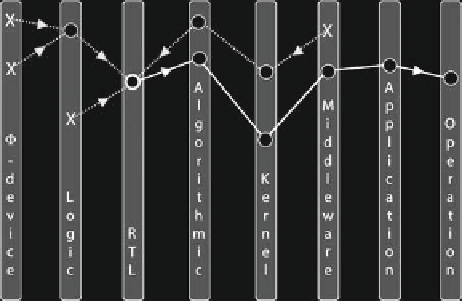Hardware Reference
In-Depth Information
X: reference fault locations — O: Observation locations
Fig. 8.14
Target system levels and fault pathology
8.3.3.2
Error Equivalences
For characterizing the behavior of a computer system in presence of faults, it is not
necessary a priori that the injected fault be “close” to the target (reference) fault. It is
sufficient that it induces similar behaviors. Similar errors can actually be induced by
different types of faults (e.g., a bit-flip in a register or memory cell can be provoked
by an heavy-ion or as the result of a glitch provoked by a software fault). What is
important is not to establish an equivalence in the fault domain, but rather in the
8.3.3.3
Distances
What matters is that the respective error propagation paths
converge
before the level
where the behaviors are observed. Two important parameters can be defined on these
-
the
distance
dr
, separating the level where faults are injected from the
reference
fault level(s);
-
the
distance
do
, separating the level where the faults are injected from the levels
their effects are
observed
.
The shorter
dr
and the longer
do
are, the more likely the injected faults will exhibit
behaviors similar to those provoked by the targeted reference faults.
8.3.3.4
Constraints on Error Propagation
In practice, the presence of a specific FTM may alter the error propagation paths.
This has a significant impact on the scope of (real) faults actually covered by the

